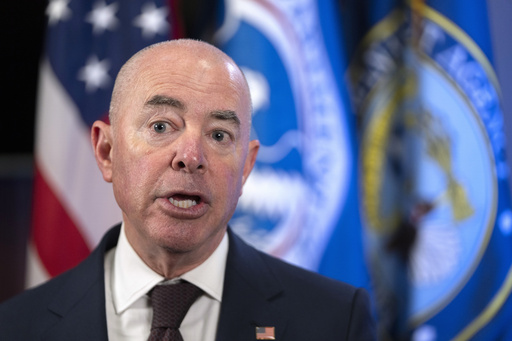WASHINGTON (AP) — The head of the Homeland Security Department said Friday that the agency tasked with responding to disasters across the country is prepared as it goes into what is expected to be an intense hurricane and wildfire season but he’s concerned about looming budget shortfalls.
As parts of the U.S. are sweltering under potentially record-breaking temperatures, Secretary Alejandro Mayorkas said extreme heat could qualify as a major disaster under a law governing how the federal government responds to natural disasters but that local communities historically have been able to deal with major heat waves or wildfire smoke without needing federal assistance.
Mayorkas spoke to The Associated Press during a visit to the headquarters of the Federal Emergency Management Agency for a briefing about the hurricane season, which started on June 1. Experts think this year could be one of the busiest Atlantic hurricane seasons on record as climate change causes storms to become more intense. Already Tropical Storm Alberto, the season’s first named storm, brought heavy rain to parts of Mexico.
Mayorkas said one reason FEMA is prepared is that the agency staff has gotten so much practice responding to disasters as climate change has intensified.
“They have exercised these muscles regrettably year after year. As the impacts of climate change have been more and more evident, we have seen and experienced increasing frequency and gravity of extreme weather events,” Mayorkas said.
Against that backdrop, the secretary said he was concerned about the size of the agency’s disaster relief fund. That’s the primary way that FEMA funds its response to hurricanes, wildfires, floods and other disasters.
“We expect the disaster relief fund, which is the critical fund that we use to resource impacted communities, we expect it will run out by mid-August. And we need Congress to fund the disaster relief fund,” he said.
If the fund runs out of money, it doesn’t mean the agency doesn’t respond to emergencies. Instead, the agency goes into what’s called immediate needs funding — redirecting money from other programs so it can respond to the most urgent, lifesaving needs. But that can take away money from longer-term recoveries.
Much of the United States has been baking in a heat wave, with numerous areas expected to see record-breaking temperatures and hot weather expected to continue through the weekend. The hot start to the summer comes after the U.S. last year experienced the most heat waves since 1936.
With climate change raising temperatures nationwide, advocates and some members of Congress have questioned whether heat waves should be considered natural disasters in the same way hurricanes, tornadoes and floods are.
Environmental and labor groups earlier this week petitioned FEMA to include extreme heat and wildfire smoke as major disasters under the Stafford Act, the law spelling out federal disaster response. They argued that both are among the biggest environmental killers and that a clear federal designation would unlock money for things like cooling centers to be used in heat waves or community solar energy projects to reduce grid load.
“In recent years, increasing extreme heat events have impacted millions of workers and communities — ranging from farmworkers sowing outdoor crops under fatal heat dome conditions, to postal workers ducking in and out of searing hot trucks, to warehouse workers experiencing record indoor heat while undertaking fast-paced physical labor, and to communities of color suffering disproportionate heat while living in concrete urban heat islands,” the petition read.
Mayorkas said the law doesn’t prevent extreme heat or smoke from qualifying as a major disaster but that the federal government only steps in to help when a local community doesn’t have the resources to respond itself. But historically that “has not been the case with respect to extreme heat and smoke,” he said.
This post was originally published on this site




